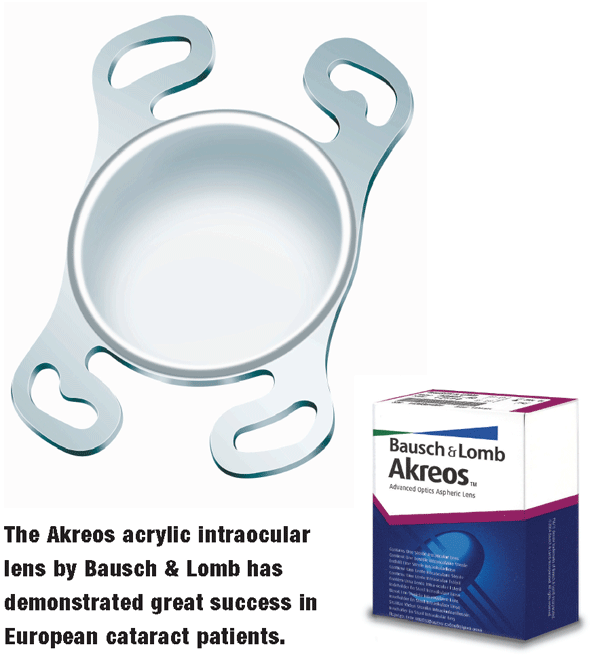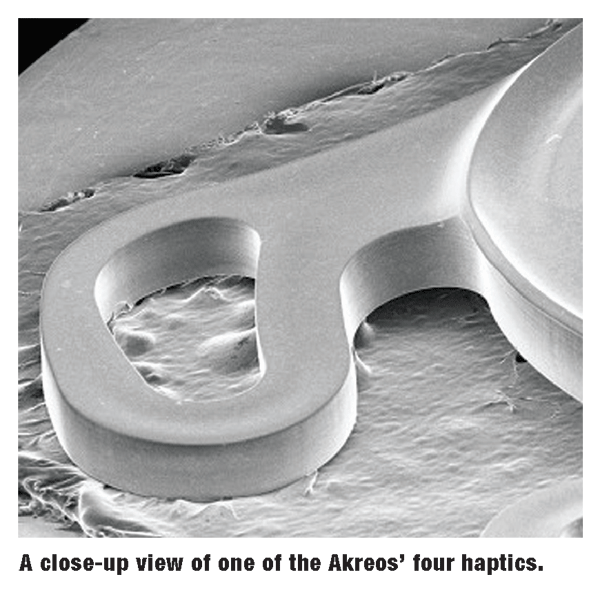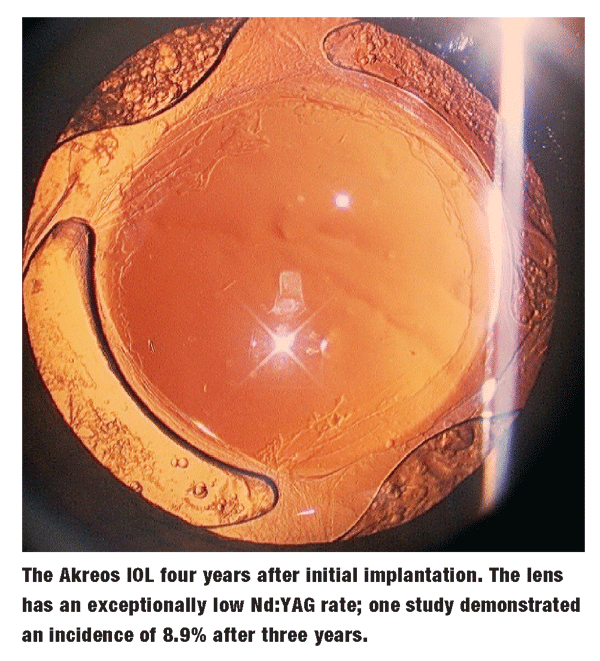 Within a few months, a uniquely designed cataract surgery intraocular lens (IOL) is expected to become available for patients in the
Within a few months, a uniquely designed cataract surgery intraocular lens (IOL) is expected to become available for patients in the
American optometrists must be aware of this emerging technology in order to adequately provide their cataract patients with news of the latest developments in IOL research.
The Akreos lens exhibits several unique features and advantages that may hasten its approval for surgical application in the
 Two similar studies on groups of 100 post-cataract surgery patients yielded a one-year Nd:YAG rate of about 4%, and a three-year Nd:YAG rate of 8.9%.2,3 By contrast, current IOLs in the United States have a typical Nd:YAG capsulotomy rate of over 48.5% within three years after implant.4
Two similar studies on groups of 100 post-cataract surgery patients yielded a one-year Nd:YAG rate of about 4%, and a three-year Nd:YAG rate of 8.9%.2,3 By contrast, current IOLs in the United States have a typical Nd:YAG capsulotomy rate of over 48.5% within three years after implant.4
European eye surgeons believe that the design of the Akreos IOL allows for 360 degrees of square-edge barrier protection from migrating epithelial cells, including the area over the haptics. This may explain why its capsular opacification rate is so low. It is worth noting Nd:YAG capsulotomy is the second most frequently reimbursed eye care surgery, costing tens of millions of dollars per year.4
Therefore, increased use of Akreos lenses could have a significant impact on the world of cataract surgery.
The Design
What is particularly unique about the Akreos IOL is that it has four haptics, instead of the standard two. Considering most ophthalmologists generally prefer to make a microincision during cataract surgery, one may believe four haptics would severely complicate lens insertion. However, the Akreos IOL folds easily and is currently being inserted through a 2.2mm incision in
Surgeons must carefully consider the material that an IOL is made from when selecting an appropriate lens for cataract surgery. Research has suggested that acrylic IOLs are fairly inert and likely better suited for patients who are prone to inflammation, such as people with diabetes or individuals who may require retinal surgery involving silicone oil.
Nevertheless, hydrophobic acrylic IOLs can accumulate water vacuoles. These vacuoles, also known as glistenings, are easily observed on slit lamp examination. However, the Akreos IOL is composed of hydrophilic acrylic material, which does not create water vacuoles.5
 Perhaps one of the more interesting findings is that many post-cataract surgery patients say that friends and coworkers frequently report observing a noticeable reflection in their pupilsthe cats eye phenomenonwhen looking at them face-to-face. Cats eye phenomenon is not readily observed with the Akreos IOL, which could be due to a combination of the lens material composition and its relatively high refractive index.
Perhaps one of the more interesting findings is that many post-cataract surgery patients say that friends and coworkers frequently report observing a noticeable reflection in their pupilsthe cats eye phenomenonwhen looking at them face-to-face. Cats eye phenomenon is not readily observed with the Akreos IOL, which could be due to a combination of the lens material composition and its relatively high refractive index.
One concern often associated with hydrophilic acrylic IOLs is the potential for calcification. Calcification is a significant problem that often requires removal of the entire implant. However, more than two million Akreos IOLs have been implanted in
A Reduction of Dysphotopsia?
The Akreos IOL is also aspheric in design, and current aspheric IOLs, such as the Tecnis Z9000 (AMO), the SoftPort AO (Bausch & Lomb) and the AcrySof IQ (Alcon), have become very popular over the previous few years because of reports of superior contrast sensitivity and fewer visual disturbances.
Aspheric IOLs allow all of the points of light to focus in one place, thus contributing to improved contrast sensitivity and night vision quality. In fact, one study showed that the Tecnis Z9000 provided up to 53% better contrast sensitivity under mesopic conditions when compared with a spherical IOL.7

The Akreos IOL combines the improved contrast sensitivity of an aspheric IOL with enhanced stability (from four haptics), which may result in an overall lower incidence of dysphotopsia. Dysphotopsia is generally defined as the observance of any visual disturbance associated with an IOL implant following cataract surgery.
Researchers at the
However, 13% of the patients who received standard aspheric IOL implants experienced severe symptoms of dysphotopsia, such as glare and halo, while only 4.6% of patients with Akreos lenses reported similar complications.8
Similarly, 75% of patients who received the Akreos implant reported only mild or barely traceable effects of dysphotopsia on the researchers official grading scale.
The Akreos acrylic intraocular lens is a very unique technology. The combination of aspheric design, acrylic material, and low dysphotopsia and Nd:YAG rates makes it a desirable addition to the cataract surgery market.
Over the next few months, it will be intriguing to see just how this technology is accepted and applied in the
Dr. Karpecki is the clinical and education advisor for Review of Optometry and is also a consultant to Bausch & Lomb.
1. Spaeth U, Liekfeld A, Hartmann C, Pham DT. Evaluation of PCO after implantation of the Akreos acrylic IOLs pilot study. Klin Monatsbl Augenheilkd 2003 Oct;220(10):695-8.
2. Robin H. One-year results with the Akreos Adapt, a single-piece hydrophilic acrylic IOL. Free Paper, Abstract 662. The American Society of Cataract and Refractive Surgery (ASCRS), 2002.
3. Lumbroso JP. One-year results with the Akreos Adapt, a single-piece hydrophilic acrylic IOL. Poster. The European Society of Cataract and Refractive Surgeons (ESCRS), 2002.
4. Cleary G, Spalton DJ, Koch DD. Effect of square-edged intraocular lenses on neodymium:YAG laser capsulotmy rates in the
5. Dhaliwal DK, Mamalis N, Olson RJ, et al. Visual significance of glistenings seen in the AcrySof intraocular lens. J Cataract Refract Surg 1996 May;22(4):452-7.
6. Apple DJ, Werner L. Complications of cataract and refractive surgery: a clinicopathological documentation.Trans Am Ophthalmol Soc 2001;99:95-107.
7. Packer M, Brown LK, Hoffman RS, Fine IH. Intraocular lens power calculation after incisional and thermal keratorefractive surgery. J Cataract Refract Surg 2004 Jul;30(7):1430-4.
8. Shambhu S,

